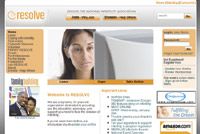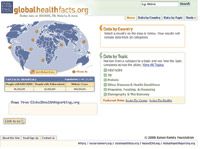Alternative Media: Masters of Their Domain
For years, educational institutions have enjoyed their own Internet domain: .edu. US governmental agencies have .gov, and non-profits have been able to set themselves apart from the crowd with .org in their e-mail and Web addresses. Thanks to changes made to the Internet's Domain Name System (DNS) in 2001, subject-specific vertical segments have been able to flee the .com world for newly established domains, such as .travel, .jobs, .museum, and .info.
For years, educational institutions have enjoyed their own Internet domain: .edu. US governmental agencies have .gov, and non-profits have been able to set themselves apart from the crowd with .org in their e-mail and Web addresses. Thanks to changes made to the Internet's Domain Name System (DNS) in 2001, subject-specific vertical segments have been able to flee the .com world for newly established domains, such as .travel, .jobs, .museum, and .info.

Alana Klein
Subject-specific domain names have many advantages. Internet addresses are proliferating: Domain registration in the .com and .net domains topped 50 million in 2005, according to Zooknic, a project that tracks use
of domain names. In a crowded environment, the right domain name can make an address more memorable. It can enhance searching. And in certain cases (most notably .gov and .edu), it serves as a sort of guarantee that a site is what it purports to be.

The entire medical community-physicians, hospitals, medical associations, medical students and residents, pharma and medical device companies, and patient groups-are taking advantage of the .md domain. "Dot md" has currently registered more than 9,000 addresses and represents the only Internet domain that serves the medical community.
There has long been interest in a domain dedicated to healthcare, and even a few attempts to launch one. The latest attempt is the new (well, sort of new) .md domain. Begun in 2004, .md currently has registered more than 9,000 addresses, including individual physicians and practices, hospitals (such as the Mayo Clinics at www.mayo.md), medical organizations (such as the National Institutes of Health, which owns www.physician.md), and companies, including Merck and Eli Lilly.
It's too early to tell whether the new medical domain will take off and become part of the public consciousness, but if it does, it could offer a new range of opportunities for communicating with physicians and patients. Certainly the experiment is promising enough that pharma marketers need to be aware of it—and perhaps start thinking about addresses they anticipate needing in the future.
Out of Moldova
The appeal to physicians of the letters "md" is obvious. "When doctors see the .md, they are immediately reminded of all the hard work and training it took them to earn their degree," says Seanne Murray, senior vice president of business development and strategic partnerships for MaxMD, the company that markets .md. "It makes them feel valued to have their own separate online identity." Still, when the system of top-level domain names was created, .md was assigned not to physicians, but to the former Soviet state of Moldova.
Moldova may own .md, but that doesn't mean that physicians can't use it as well. MaxMD has licensed the right to market .md in more than 90 countries (though not in Moldova itself). The company's goal is to create a full-fledged online community of healthcare providers. For now, it is pursuing that goal by developing a range of services designed to meet specific physician needs.
Already available are Web design and hosting for physician practices that want their own sites, and an e-mail service, using proprietary software created by BlueTie, designed to be compliant with the privacy provisions of the Health Insurance Portability and Accountability Act (HIPAA). The e-mail service includes spam and virus filtering, secure encrypted communication of confidential information, full audit capability, and access control for commonly used electronic documents.
Moving forward, MaxMD plans to offer information services, aggregating Internet resources, but also providing news, white papers, forums, and research findings on medical, legal, and practice-management topics. The company has created an independent medical advancement council to direct this effort. (A description of the board, plus a small sample of original content, can be found at www.medcouncil.md.)
"We are helping to ensure that physicians are up-to-date with their educational training," says Michael Lemon, president of the Postgraduate Institute for Medicine and member of the .md online medical advancement council. The council represents an impartial group of industry experts. "Their goal is to figure out ways to safely and effectively leverage the power of the Internet for the medical community," Murray says.
Physician-Patient Dialogue
Moving forward, MaxMD plans to introduce a Web-based medical desktop that will allow the medical community access to all of these resources. Many physicians already have shown great interest in the desktop. Eighty-one percent of physicians said the medical desktop would be useful to their practice, according to survey data conducted by MaxMD in 2005.
The medical desktop will maximize educational opportunities for patients too. "Consumers have real significant trust issues with the industry. They often don't feel they have the resources to get the truth," Lemon says. In many cases, physicians don't have time to educate patients. A healthcare domain has the potential to change the way physicians communicate with patients. "Physicians can choose which patient education information is most relevant to their practice and then drag and drop the information onto their personal Web site," says Murray. Through their Web sites and .md e-mail accounts, physicians can stimulate a dialogue with patients.
Murray sees a role for pharma in .md, especially in the area of creating educational content targeted at physicians via the desktop service. "It's like a Bloomberg for doctors," Murray says.
Embracing Online Technology
Physicians are heavy users of the Internet, but in data collected in 2002 by the American Medical Association, only three out of ten physicians using the Internet had their own Web site. "They are concerned about how to use the Internet to effectively communicate in a secure fashion, while keeping compliant with HIPAA regulations," says Murray.
Further, the volume of information on the Internet makes it difficult for the medical community to quickly and reliably access relevant information. MaxMD's bet is that a free-standing domain dedicated to the medical community will have a power that portal-based models haven't displayed yet, and that it will both encourage physicans to change the way they practice and provide them with the tools to do it. "As technology evolves, physicians will choose to present themselves differently," says Lemon. "The Web is one way to do that."
Launches Roche launched a new version of its Desktop Flu Tracker, to help people follow the spread of the flu season in their communities. // RESOLVE launched an infertility informational Web site, ww.resolve.org // Consumer Reports Medical Guide started a free, online section of its site for answering questions about avian flu. // The Kaiser Family Foundation launched globalhealthfacts.org, a free site for information about HIV/AIDS, tuberculosis, malaria, and other health issues. // Ovid Technologies launched clinicalresources@ovid.com, a database that provides information about peer-reviewed studies to medical professionals. // Epocrates debuted an online version of its free mobile drug and formulary guide. // Mobile Healthcare launched a diabetes self-management system for cell phones and the Web, Lifewatcher. //DataLabs launched DataLabs Clinical, a management system encompassing paper data entry and electronic data capture.

resolve.org
Awards A screen loop about Humalog by Blue Diesel received a Global Award in the exhibition/convention category.

globalhealthfacts.org
People Interlink Health Communications expanded its multimedia team by promoting Steve Lederman to vice president and director of production services. It also hired Patrick Boyce as senior Web developer and Todd Juro as multimedia specialist. // Paul W. Brient joined the board of directors at the GetWellNetwork.
Accounts Our Lady of the Lake Regional Medical Center implemented ProviderLink's software. // Interlink Healthcare Communications received the Web site account for a Bristol-Myers Squibb central nervous system brand.
Alana Klein is Pharmaceutical Executive's senior associate editor. She can be reached at aklein@advanstar.com

FDA Outlines Updated Requirement for Placebo-Controlled Trials in Vaccine Research
May 21st 2025In an article recently published by The New England Journal of Medicine, FDA higher-ups Vinay Prasad, MD, MPH; and Martin A. Makary, MD, MPH, wrote that any new COVID-19 vaccine must now be evaluated in placebo-controlled studies.
Addressing Disparities in Psoriasis Trials: Takeda's Strategies for Inclusivity in Clinical Research
April 14th 2025LaShell Robinson, Head of Global Feasibility and Trial Equity at Takeda, speaks about the company's strategies to engage patients in underrepresented populations in its phase III psoriasis trials.
Beyond the Prescription: Pharma's Role in Digital Health Conversations
April 1st 2025Join us for an insightful conversation with Jennifer Harakal, Head of Regulatory Affairs at Canopy Life Sciences, as we unpack the evolving intersection of social media and healthcare decisions. Discover how pharmaceutical companies can navigate regulatory challenges while meaningfully engaging with consumers in digital spaces. Jennifer shares expert strategies for responsible marketing, working with influencers, and creating educational content that bridges the gap between patients and healthcare providers. A must-listen for pharma marketers looking to build trust and compliance in today's social media landscape.